The Public Houses of the Ancient Parish of Barwick-in-Elmet
The History of the New Inn, Barwick
Article updated and expanded from The Barwicker No. 94 - June 2009

New Inn, Main Street, Barwick-in-Elmet.
The New Inn public house stands at the junction of Leeds Road, Main Street, Long Lane and Chapel Lane at Barwick. In the past it was ideally located to catch weary travellers heading to Barwick from the west and the south as well as providing refreshment to village locals. It is quite clearly not a purpose-built public house looking more like a row of cottages converted at some time into the now popular drinking establishment.

New Inn, Main Street, Barwick-in-Elmet.
When did this happen and actually how new is The New Inn? It has certainly never been new in my lifetime or my fathers. Even my great grandfather, Stephen Sheldon Teal, living in the village in the 1940's would have not known it as new or spoken with anyone then living who did. To find people using it as new we must go back 190 years, to the 1830's. To a time when William IV and then a young Queen Victoria were on the throne and most villagers would be engaged in farming or working in the local collieries. We must go back to the Beer Act of 1830 and the explosion in the number of beer drinking establishments which followed the passing of this Act of Parliament.

1830 Beer Act.
The Beer Act of 1830 allowed any ratepayer (with limited conditions) to buy a license to brew beer, ale, or cider only and sell it in their own home. The licenses were issued direct by the Excise Office without the need to go in front of the local Magistrate. Innkeepers who sold spirits as well as beer had to obtain their licenses from the licensing Magistrate. The Government had become concerned about a rise in drunkenness around the country through the consumption of strong spirits in the so-called "Gin Palaces". They also wanted to put a check on the increasing stranglehold the large breweries had on Inns and Taverns in many towns which was stifling competition. Beer was viewed as a wholesome, nutritious drink especially when compared to the quality of the water in many places. The licenses cost two guineas (one if only cider or perry was brewed) and were valid for twelve months. Across the country 31,937 beerhouse licenses were issued in 1831 to trade alongside the 50,547 full ones issued to Inns. This was a massive increase in the number of drinking premises and Barwick was not left behind with the "New Inn" beerhouse and now closed "William IV" beerhouse on Aberford Road opening to join the existing full license Inns "The Gascoigne's Arms" and "The Black Swan"
The "New Inn" buildings are older than the 1830s but exactly when they were constructed is not known. Ownership of the site can be traced back to 1635 when Thomas Rawson gave his daughter Elizabeth, just prior to her marriage to Thomas Vevers, a cottage and land in Barwick.

Thomas Rawson surrenders land to his daughter Elizabeth Rawson at the Barwick and Scholes Manor Court held on the 5th August 1635
Reproduced with permission of the West Yorkshire Archive Service, Leeds, WYL115/E1/35 Page 3 (www.wyjs.org.uk/archives).
In 1652 these premises were transferred by Thomas and Elizabeth Vevers to Alice Watkinson (wife of William Watkinson of Tadcaster) and then to her son Robert Watkinson in 1680. He mortgaged the premises for £15 in 1690 to Ann Moore, a spinster. This mortgage appears to have been unpaid for the now married Ann Hulley transferred the premises in 1719 to Richard Braime and his wife Anne.

Joseph Hulley and his wife Anne surrender the premises to Richard Braime of Barwick and his wife Ann at the Barwick and Scholes Manor Court held on the 7th October 1719
Reproduced with permission of the West Yorkshire Archive Service, Leeds, WYL115/M1/22 Skin 10 Side 1 (www.wyjs.org.uk/archives).
The widowed Ann Braime transferred it to her son Thomas Braime in 1758 when the site was occupied by William Tipling. He transferred it to Thomas Taylor and his wife Mary in 1767.
It may have been Thomas Taylor who constructed or perhaps reconstructed the buildings on the site because by 1797 they are described as "house at Barwick where William Tipling formerly lived and Thomas Taylor lately lived and now divided into 3 where David Strother, Renton Haiste and Thomas Waite live."
Thomas Taylor sold the larger and southernmost of the cottages in 1800 to David Strother, a yeoman of Barwick, retaining the right of access to a well outside these premises for the other two cottages. Later in 1808 he sold the remaining northern two cottages for £55 to Robert Marsh of Thorner, a shoemaker, and his wife Elizabeth, although the cottage where a Bennet Johnson lived was to be given to Thomas Taylor's grandson, Joseph Robinson, a collier of Barnbow, when Robert Marsh died, an event which happened in 1818. The three cottages were then split across three owners.
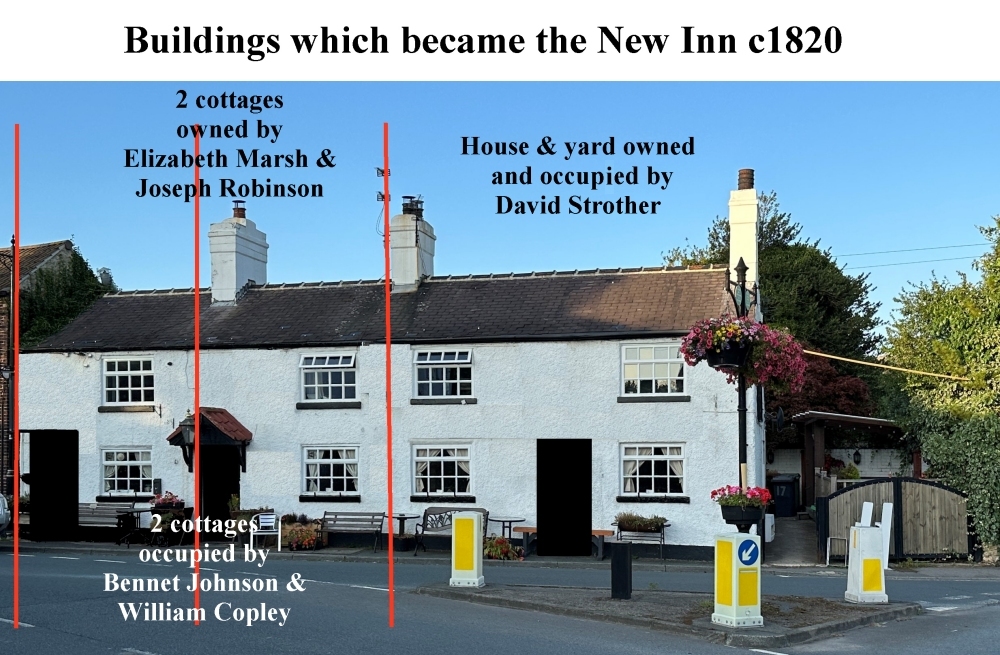
Buildings which became the New Inn, c1820.
In 1825 David Strother sold his cottage to Edward Wales, a wealth linen draper from Leeds, who purchased much property in Barwick and retired to the village living in what is now Elmwood House. The well of this cottage was still shared with two other adjacent properties who had to pay two thirds of its upkeep or else they would lose the right to use it. They also had a right to go over the site to get to the Town Street of Barwick with ashes and manure, but only between the 1st May and the 1st June each year. Edward let this property to William Gough, a gardener.
On the 3rd September 1836 Richard Hewitt bought the other small cottage from John Marsh of Thorner, the son and heir of Robert Marsh, for £50 and opened a beerhouse and shop in the northern part of the current premises.

1841 Valuation Map of Barwick, Richard Hewitt and his beershop in the 2 smaller northern cottages, numbered 974 on the map and containing 4 perches of land.
Reproduced with permission of the West Yorkshire Archive Service, Leeds, WYL115/MA12 (www.wyjs.org.uk/archives).
Richard was born in Barwick on the 20th December 1796 the son of John Hewitt a miner. He married Jane Ward in 1823 and had three children. His wife Jane died in 1840 aged just 36 and Richard remarried Harriet Dawson of Scholes in 1842. They had one daughter together, Jane, baptised at All Saint Church, Barwick on the 25th March 1843. Richard is described until the 1830s as a labourer. In 1834 he appears in a local directory as a retailer of beer in Barwick and from 1838 as a beerhouse keeper. He appears to have left the Parish at some stage after the death of his first wife and when he married Harriet on the 26th April 1842 at Leeds Parish Church (St. Peters) he is described as a labourer of Holbeck. Whether the beerhouse closed during this period or was run by someone else is not known. By the following March however he is back at Barwick described as beerhouse keeper in the Parish Registers.

3rd August 1841 - Barwick Parish Valuation - Richard Hewitt and his beershop in the 2 smaller northern cottages.
Reproduced with permission of the West Yorkshire Archive Service, Leeds, WYL115/XA12/1 (www.wyjs.org.uk/archives).
On the 29th April 1851 Richard bought the adjoining southernmost part of the current New Inn from Edward Wales for £140 and extended the beerhouse. Later descriptions in property deeds describe that the "premises are now thrown together and form the New Inn in Barwick".
The earliest written reference to the name "New Inn" is from the 1861 census when Richard and Harriet with a daughter from his first marriage, Elizabeth, and the 18 year Jane are all living in the property.

1861 Barwick Census showing Richard Hewitt run a Beerhouse called the New Inn, the 1st written reference to the name.
Richard died on the 24th February 1870 and his will written on the 18th July 1868 states "I give and devise all my copyhold cottages or tenements known by the sign of the New Inn in Barwick−in−Elmet...in trust...to my wife Harriet to receive rents while alive then to be sold". Harriet died in 1878 and the inn was then bought from the trustees of the will by her daughter Jane Hewitt for £150 who then ran the business in her own right. In the 1881 census she is listed as unmarried beerseller, aged 38, helped by Sarah Wilson, also unmarried, a 50-year-old general domestic servant. James Haley, a 39 year old agricultural labourer, born in Bramley was also visiting.
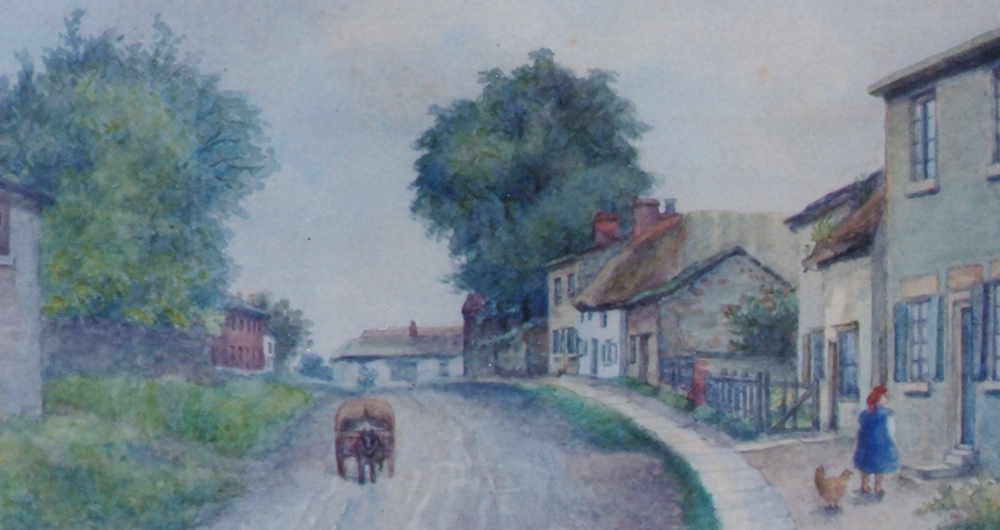
c1870 painting looking along Main Street with the New Inn showing on the left in the distance.
By the 1891 census Jane is shown as a licensed victualler and James Haley is still resident described as a border aged 49, living on his own means (usually savings or an annuity).

New Inn and Main Street c1890.
On the 12th January 1898 Jane made her will leaving everything she owned included "The New Inn" to James Haley, the border who had lived with her at least 17 years. She died on the 10th April of that year aged 55 and was buried in the churchyard at All Saints, Barwick. Six weeks later James Haley, now the Inn keeper at the "New Inn" married the Barwick widow Annie Cason Ellis (nee Williams) again at All Saints. It is difficult to pass judgement on what happened next as the records have not survived or as yet have not come to light. The Hewitt family, likely expecting a share of the estate, possibly upset by the timing of James's marriage to Annie challenged the validity of the will. The grounds for the challenge are not known but a court case entitled "Haley against Hewitt" was held in Wakefield on the 20th December 1898 when a Judge ruled that the will was indeed valid. The total value of the estate was £1,027 15s 8d with the full amount going to James.
James then moved with his new wife Annie to live in Scholes, he is shown as a retired publican in the 1901 census. The "New Inn" was let to tenants with Charles Wrigglesworth and his wife Sarah running it in 1901. James died in 1906 and his widow Annie sold the inn on the 11th October 1906 to the John Smiths Tadcaster Brewery Company. This large brewing company were buying inns which were then supplied by their brewery at Tadcaster and rented to tenants.
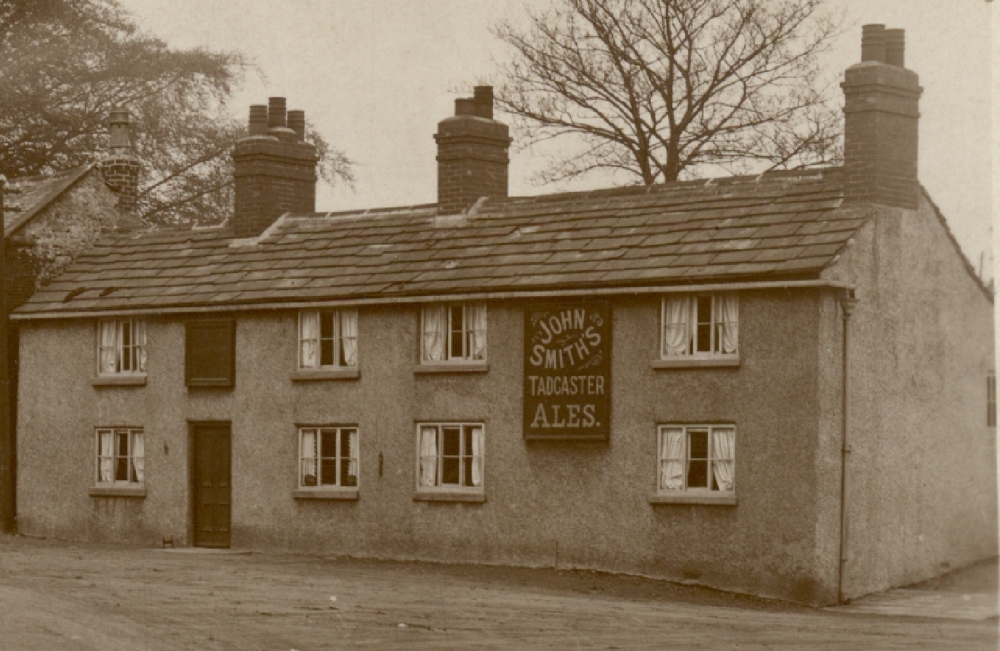
New Inn about 1900.
The property has been held under a Manorial system of ownership called "copyhold" in the Manor Court of Barwick and Scholes. In 1913 John Smiths Tadcaster Brewery Company paid the Lord of Manor, then Colonel Gascoigne of Lotherton, £135 5 shilling 2 pence to free this property and the nearby Black Swan Inn, which they also owned from all Manorial restriction and it then became freehold.
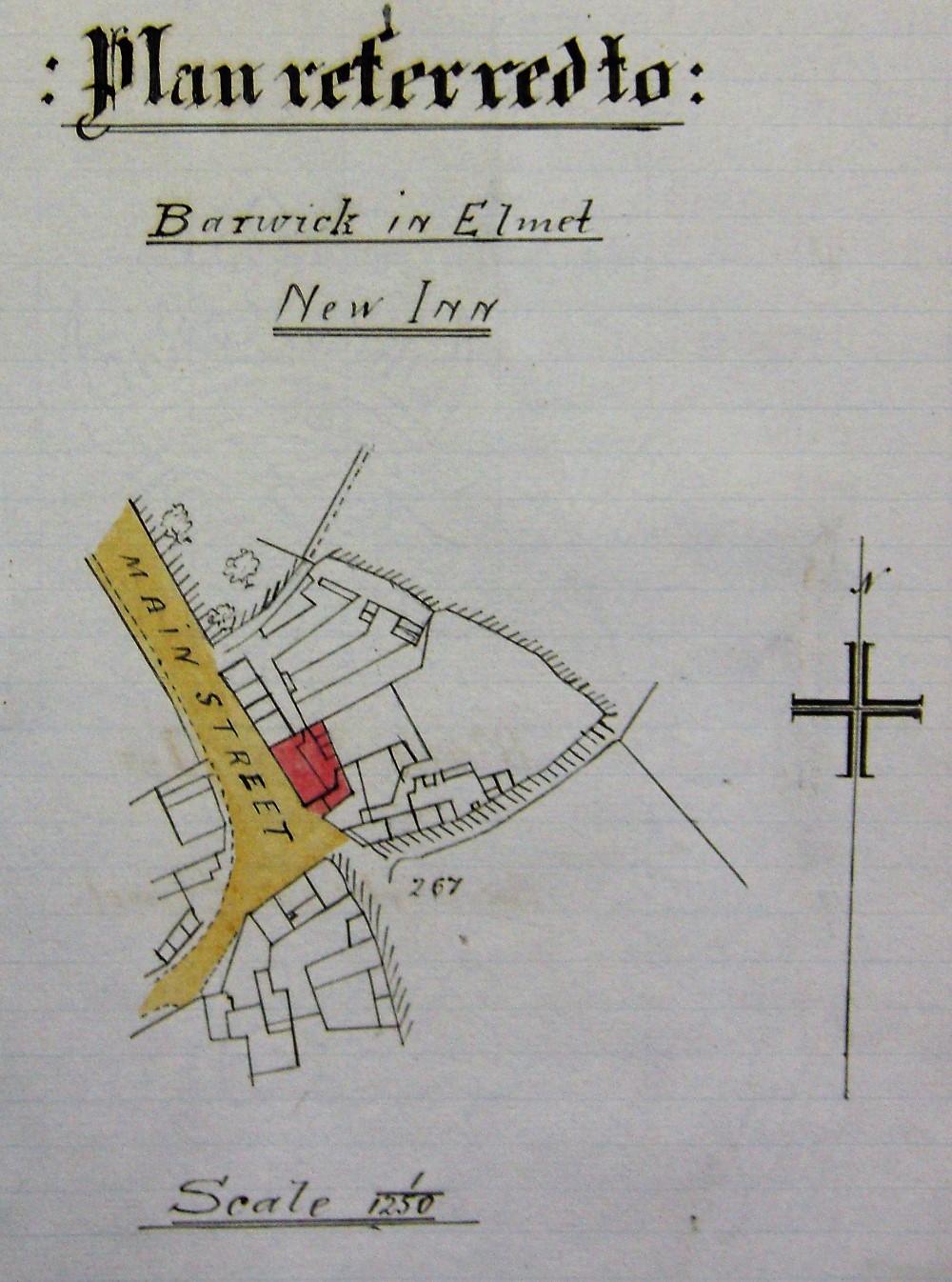
Barwick and Scholes Manorial Records 1913 showing area John Smiths Brewery converted to freehold.
Reproduced with permission of the West Yorkshire Archive Service, Leeds, WYL382 acc/1578/216 (www.wyjs.org.uk/archives).
Charles Wrigglesworth ran the inn until the 29th December 1914 paying a rental of £25 per annum.
The licensees and notable events of the twentieth century were:
29th December 1914 − 2nd November 1920 − Edmund Burnett
Edmund served as Maypole master at the 1919 Barwick Maypole raising (after a 6 year gap due to World War I) "Come along, ye men of Barwick, come along and do a man's duty" through a megaphone it is beleived he said as he stood on the market cross like a captain on the quarter deck giving clean cut orders with a cool assurance and a sense of mastery that inspired both confidence and admiration one of the local newspaper reported.
2nd November 1920 − 27th October 1925 − Harry Garbutt

Kellys Directory of the West Riding of Yorkshire 1922 - Haryy Garbutt, Beer retailer in Barwick.
27th October 1925 − 24th January 1933 − Samuel Cross
The sanitary facilities were modernised in late 1931. (Ed note : I'm not sure the gents have been updated since!)
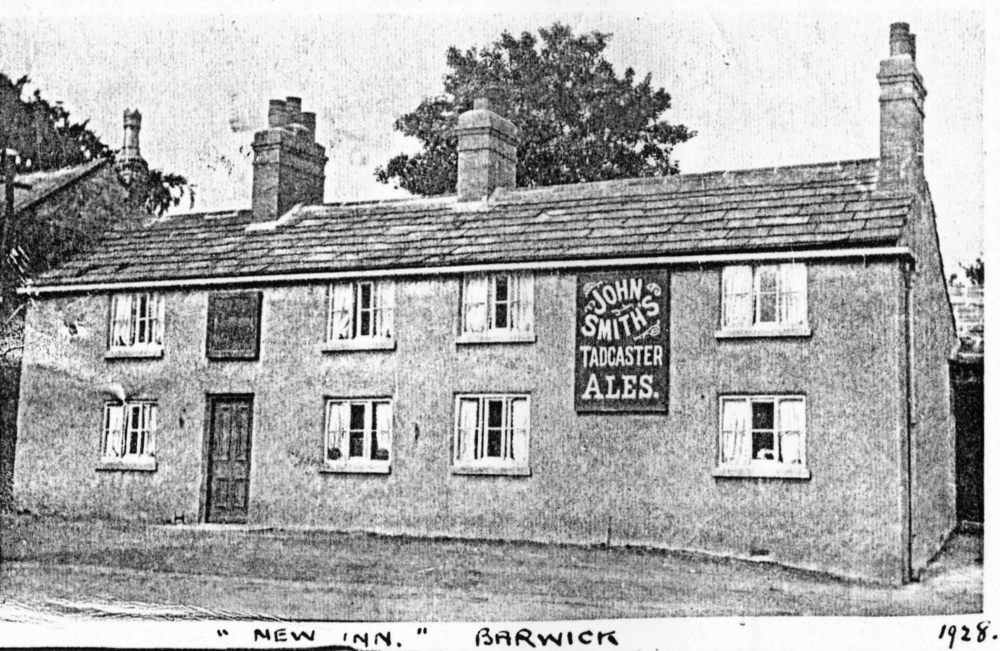
New Inn 1928.
24th January 1933 − 1st September 1936 − Robert Arden
1st September 1936 − 18th November 1941 − Harry Garbutt
18th November 1941 − 3rd July 1951 − Harold Snaith
3rd July 1951 − 13th April 1954 − Henry Horsman
13th April 1954 − 11th August 1970 − Evelyn May Tyson
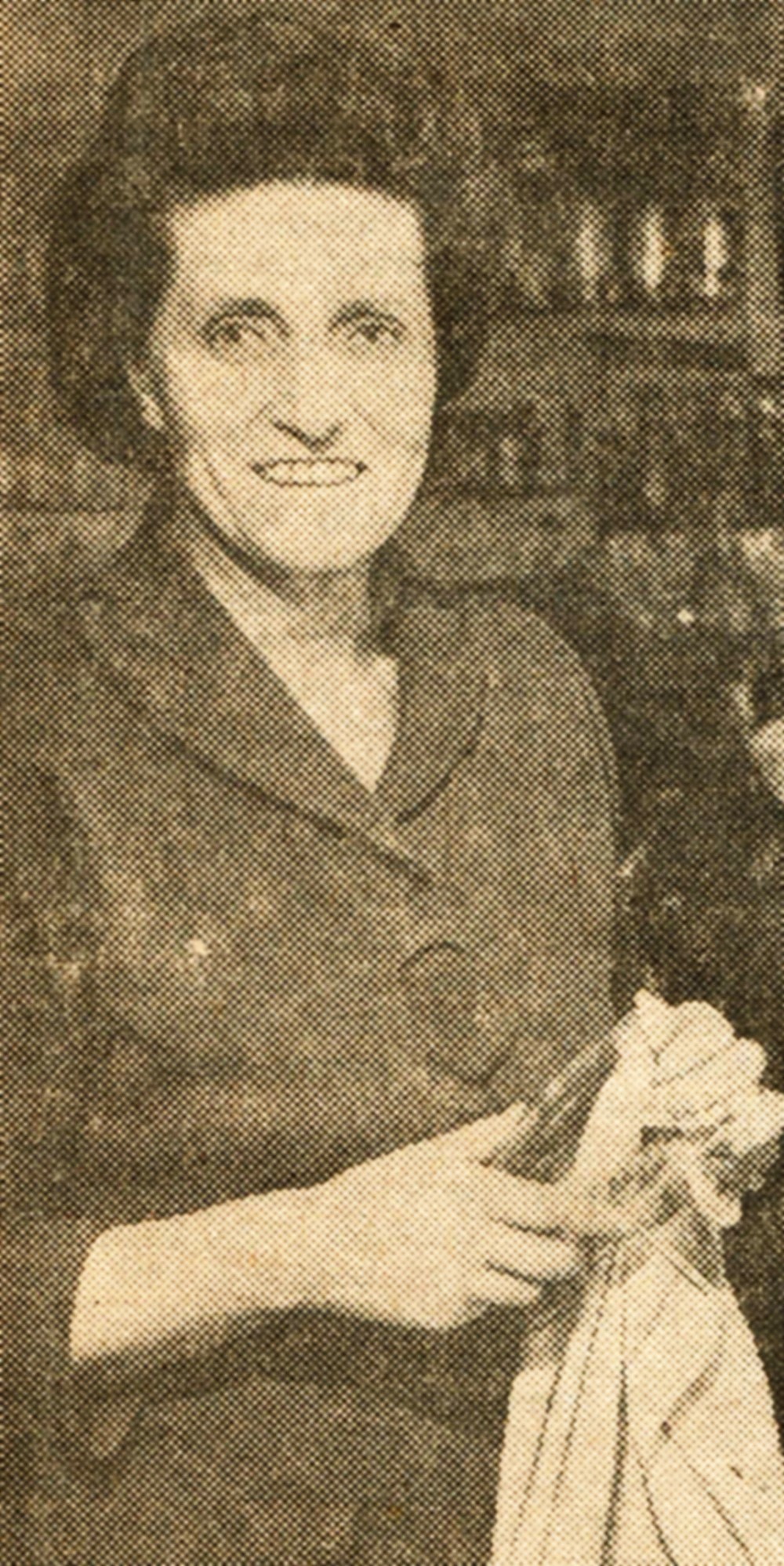
Landlady Evelyn Tyson at The New Inn in 1960.
On the 7th February 1961 Evelyn Tyson applied to the Skyrack Licensing Court for a full Publicans License, it was supported by a petition signed by 257 customers. The application was successful meaning the "New Inn" could sell spirits and wine as well as beer for the first time in 130 years.
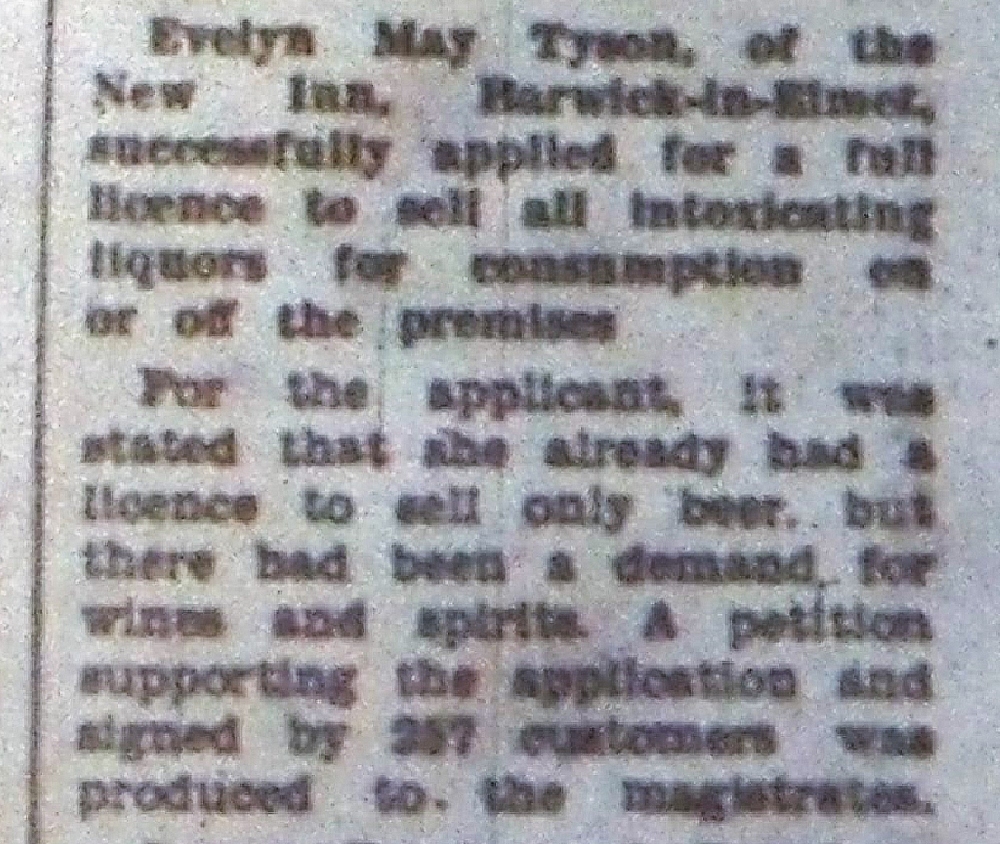
February 1961 and the New Inn Beerhouse can sell wines and spirits!
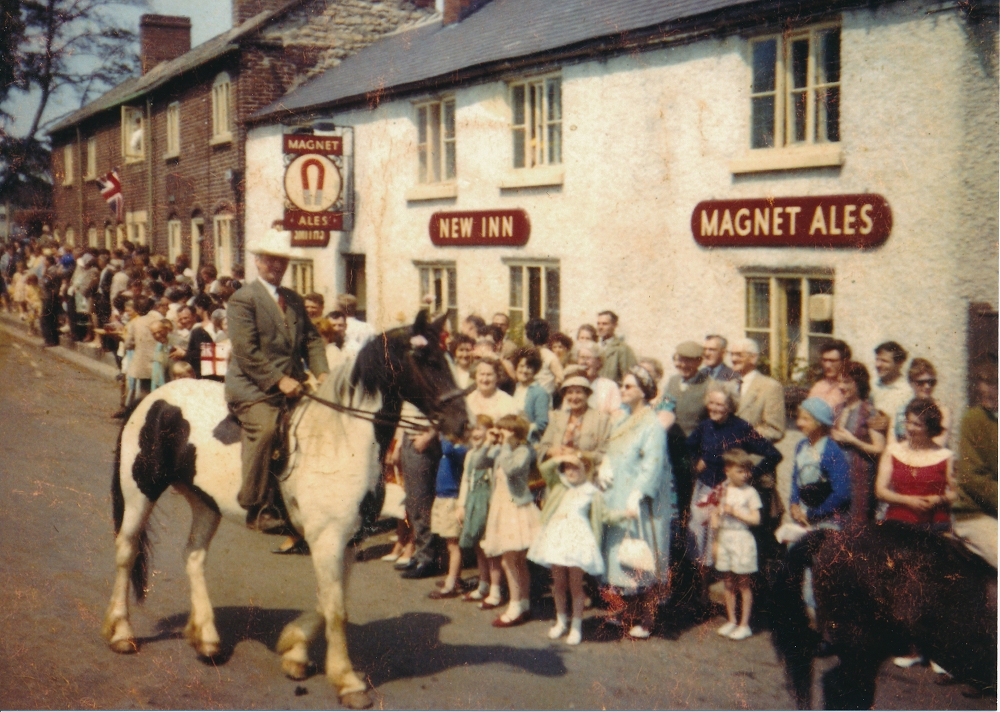
New Inn, Maypole day 1963.
11th August 1970 − 1986 − Kevin Bottomley
1986 − Pauline Bottomley
In 1984 internal alterations were completed including the removal of a wall making the bar and snug one room increading the amount of space for customers.
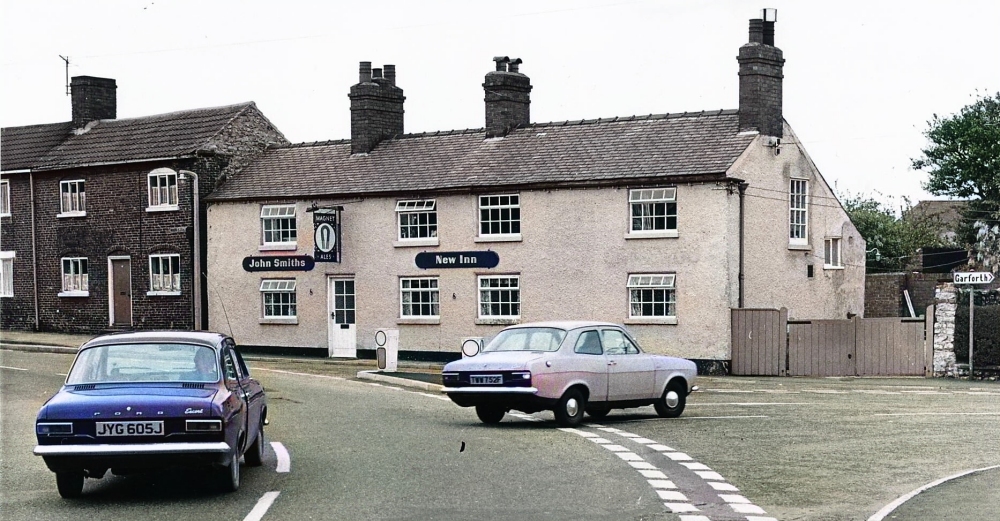
New Inn, 1974.
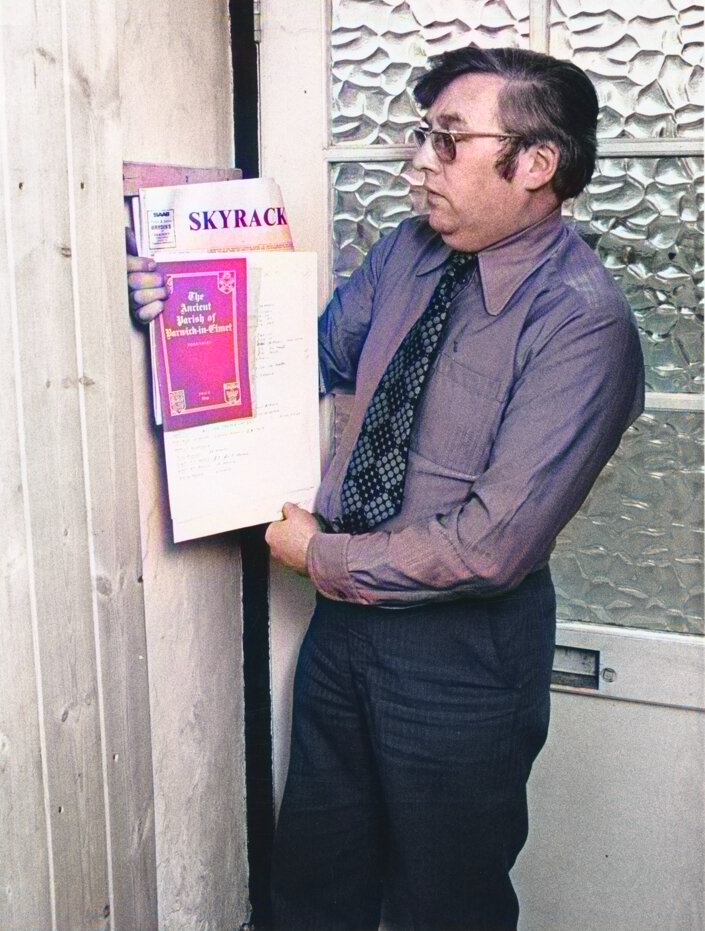
Landlord Kevin Bottomley − February 1976.

c1980.
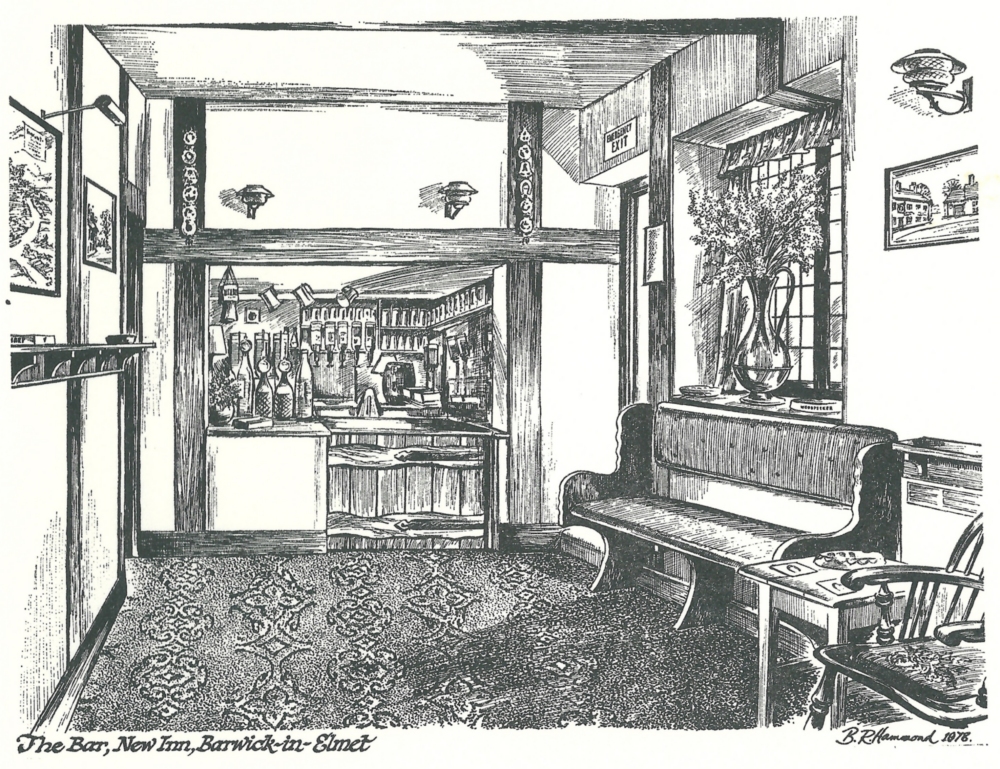
The Bar − 1978.
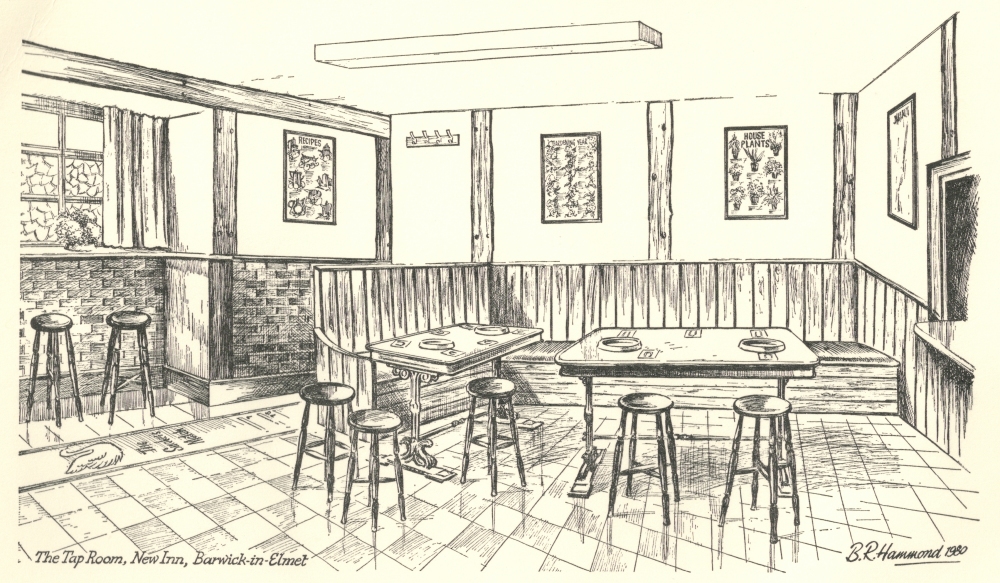
The Tap Room − 1980.
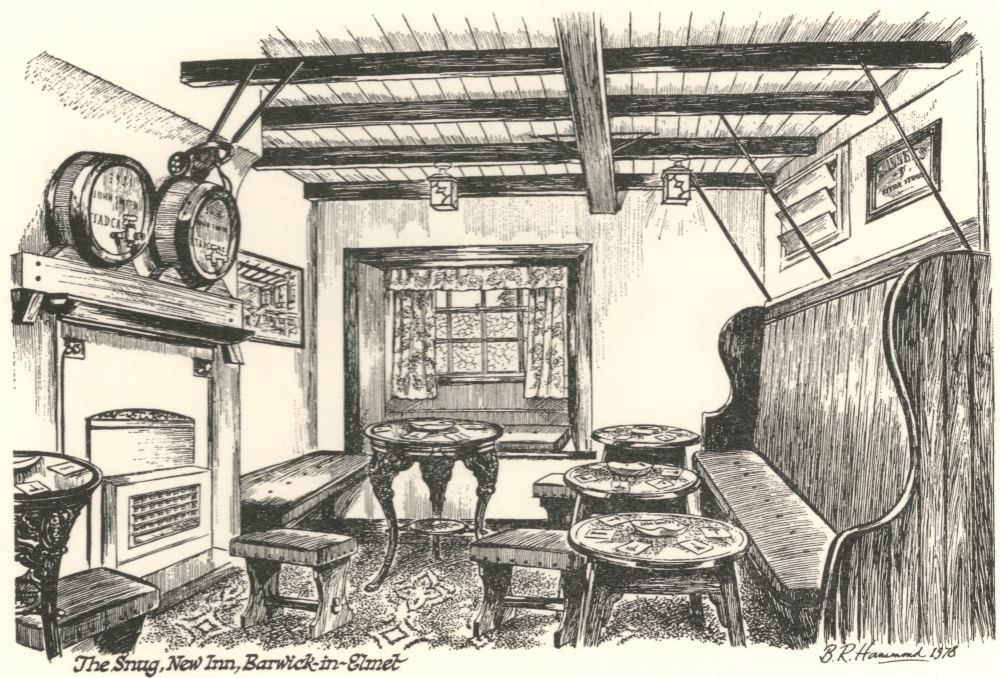
The Snug − 1978.
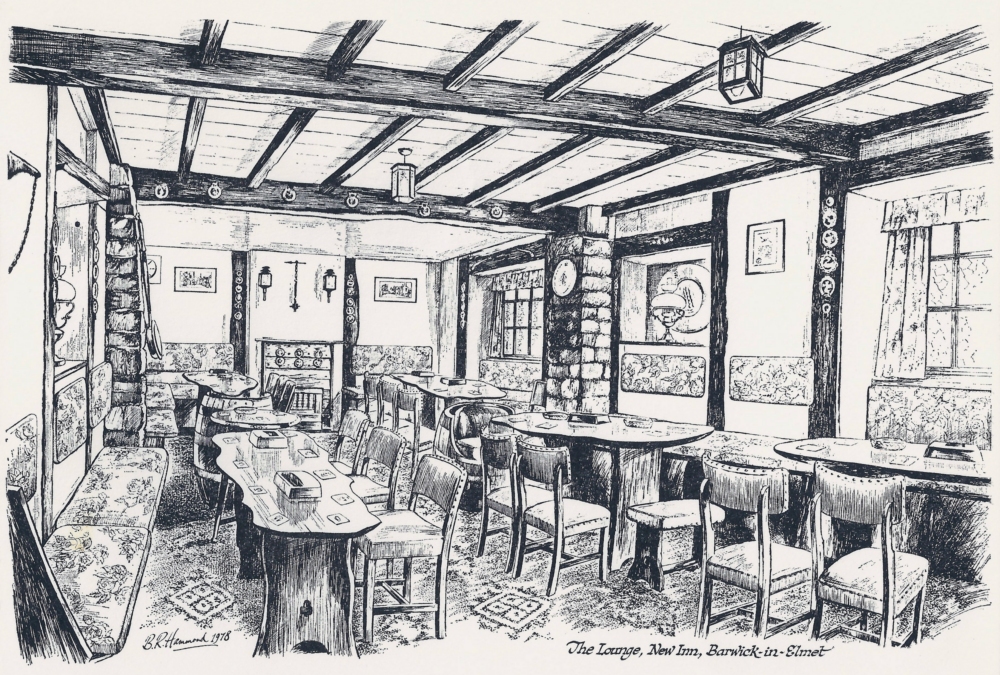
The Lounge − 1978.
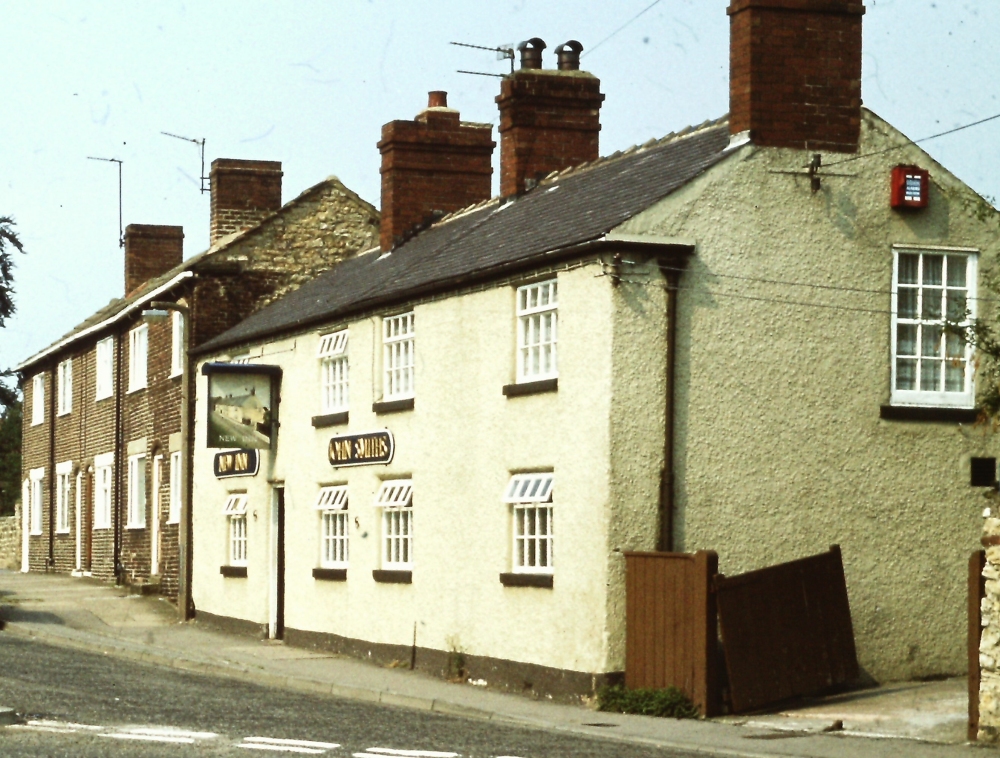
New Inn c1980.
1986 − March 2006 Peter Weatherill

Landlord Peter Weatherill as the Barwick Town Crier on Maypole Raising Day 1999.
March 2006 − 2014 − Gary & Annette Shepherd. They introduced live music on a Sunday nights usually a single instrument and singer as well as "open mike" for anyone who wanted to sing for 10 minutes. The fireplaces which had been closed were re-opened and real fires provided in winter.
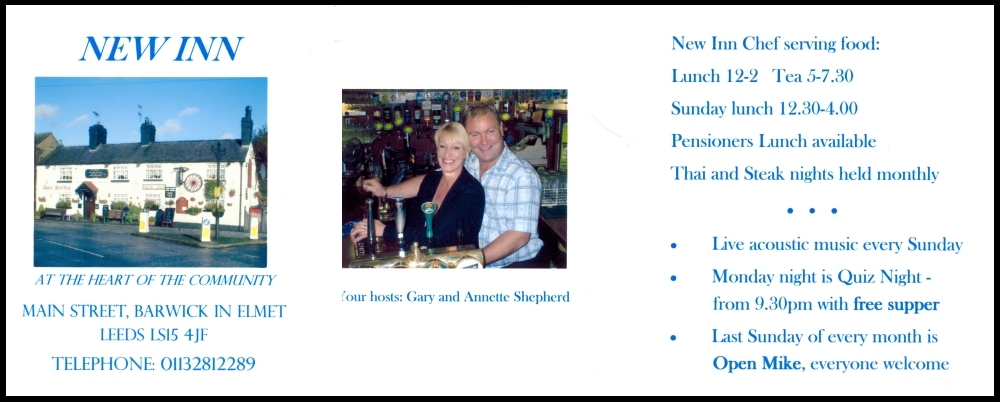

Landlord Gary Shepherd as the Barwick Town Crier on Maypole Raising Day 2011.
2014 − 2018 − during this time the New Inn was closed for short periods and run by a number of people including Holly Gillan, Andrew Gough & Paul Roberts.
2018 − September 2023 − Pawel Pav Bielecki, the Newinnski.

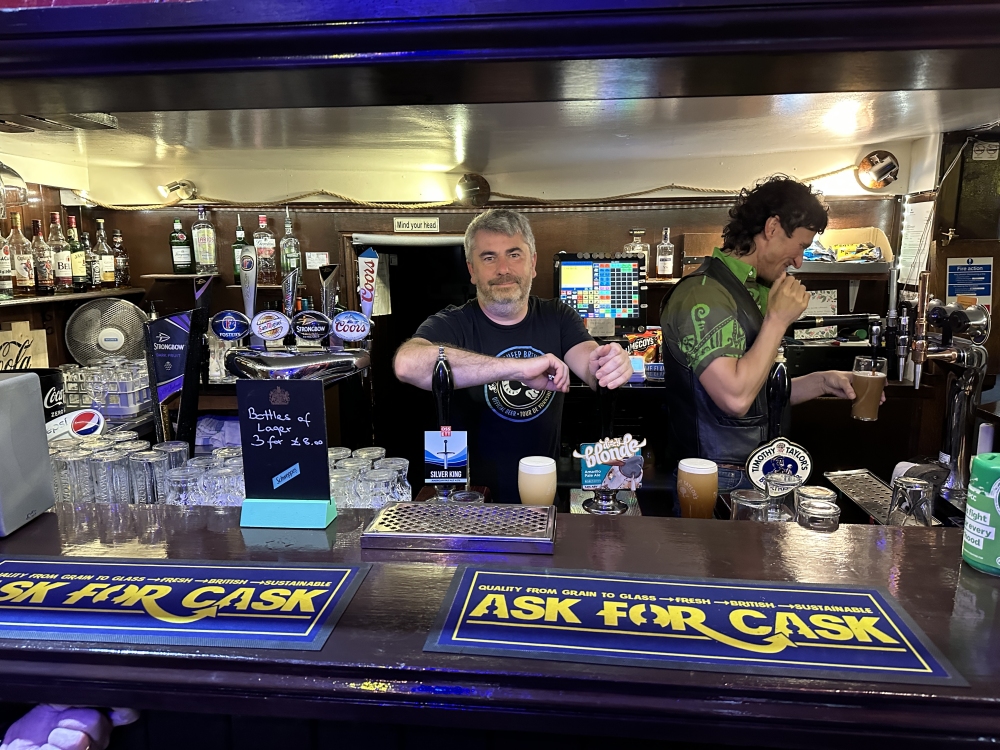
Pav behind the bar, 1st September 2023.
The John Smith Tadcaster Brewery Company was taken over by the Courage Brewery in the 1970s.
By the 1980s brewing and pubs in the UK had come to be dominated by giant companies known collectively as "The Big Six" which including Courage. Starting in 1989 the Government, on recommendations from the Monopolies and Mergers Commission, decided to cut the breweries hold over public houses and they were forced to start to sell their pub estates.
In 1991 Courage sold the "New Inn" to the Inntrepreneur Pub Company who subsequently sold it to Unique Pub Properties Limited in 1999. In 2004 Unique Pub Properties was sold to Enterprise Inns who were renamed EI Group plc in 2017. In March 2020 this group was sold to the Stonegate pub company based in Solihull and who operate around 4,800 managed, leased and tenanted pubs in the UK.
It certainly remains a "Unique" public house, a jumble of rooms at different levels with the smallest serving bar or hatch I've ever seen. Perhaps the name "New" is now misleading, it has a long and proud history, should it be renamed the "The Old Inn"?
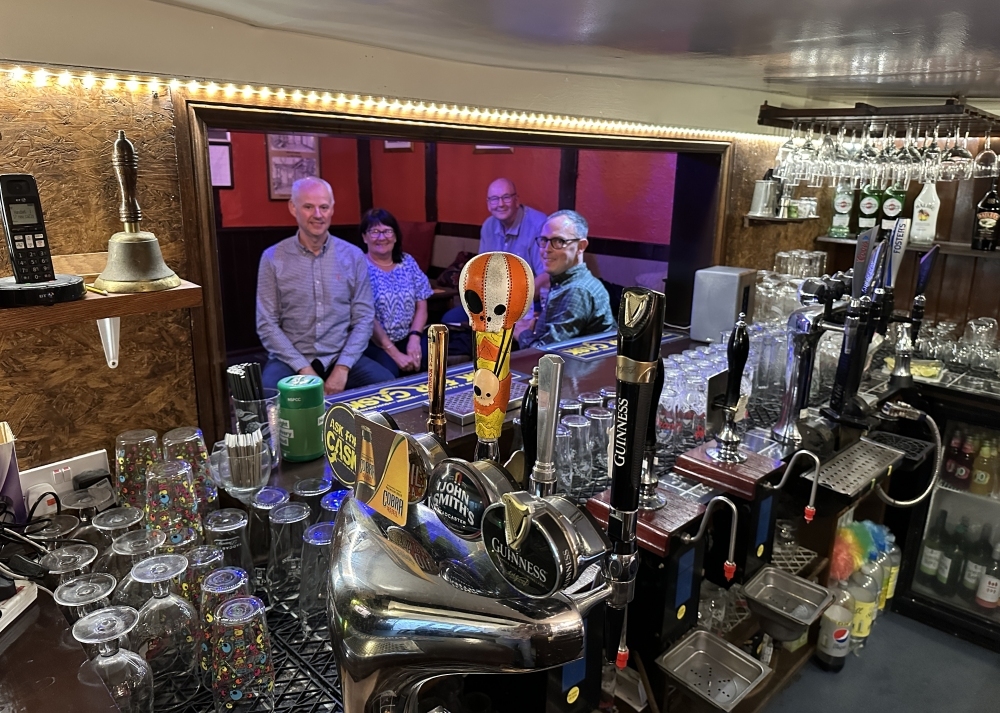
A happy night in the New Inn, August 2023, hopefully not a final one?
Dave Teal
September 2023
Sources:
− Barwick−in−Elmet and Scholes Manorial Records
− 1841 − 1911 Census Returns
− 1909 Valuation Office Records
− The Skyrack Courier Newspaper
− Probate Records − Her Majesty's Court Service
− All Saints Church, Barwick−in−Elmet, Parish Registers
− St. Peter Church, Leeds, Parish Registers
− Local Directories
− Paul Jennings − "The Local" A History of The English Pub
− Land Registry of England and Wales
− Skyrack Petty Sessions − Registers of Alehouse Licenses
− Archives of the Barwick Historical Society
Back to the top
Back to the Main Historical Society page